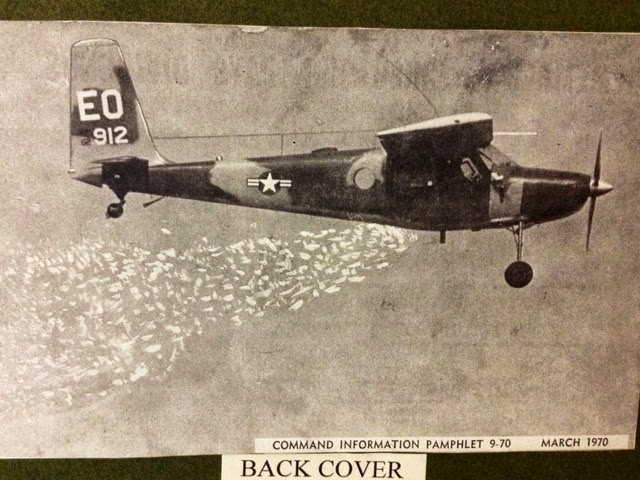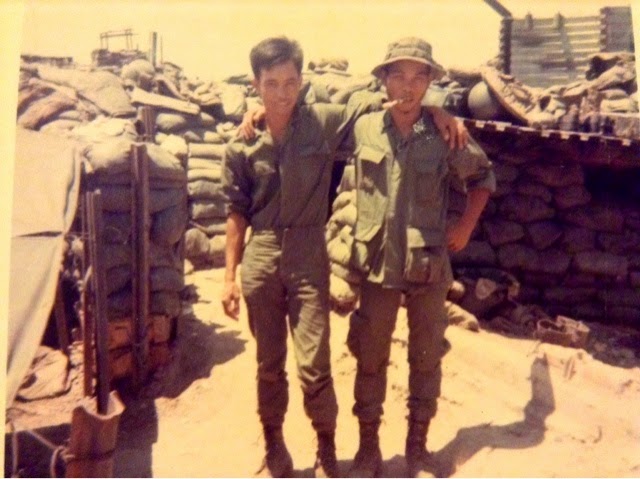Ho Chi Minh's propaganda machine was equalled to, if not surpassed, his charismatic statesmanship. His use of propaganda along with his writings attempted to unite political and social issues for the ultimate liberation of Vietnam. Ho Chi Minh (the bringer of light) was a skillfull statesman and adapted revolutionary strategies with propaganda to defeat his enemies.
Uncle Ho as the world came to know him appeared on many propaganda leaflets. Always appearing with an enigmatic smile he was an inspiration to his people unfortunately Ho did not live to see his beloved Vietnam reunified. His death inspired a tremendous outpouring in Vietnam adding significantly to the powerful imagery surrounding his name. His picture along with his spoken words adorned many propaganda programs. His use of destroyed military equipment was another powerful tool used by Hanoi. Often used by adversaries to powerful nations the weaker less aggressive combatants revel at the sight of destruction. It invokes a sense weakening, waste, and uselessness by the more formidable opponent.
To combat the growing unpopularity of the war the United States set up the Combined Documentation Exploitation Center (CDEC). It's job was to evaluate and translate documents obtained from prisoners of war or enemy killed in action. Information was then forwarded to units in the field.
1st Lieutenant Frederick "Rick" Walsh headed up the CDEC in Saigon from September 1967 to October 1968. Mr. Walsh donated a portion of the documents contained in THE ART OF WAR exhibit shown below. Considered non sensitive material at the time they illustrate the use of propaganda during wartime. Hanoi's propaganda machine was equalled to that of the allied forces.
The Allied Forces with the U.S. leading the way had it's own brand of propaganda and it littered the countryside with its message. Most leaflets were pictures of dead Vietnamese accompanied by questionable slogans such as "I gave my life for freedom." But the biggest and most widely known propaganda program was the Chieu Hoi program.
Chieu Hoi (Open Arms) was an amnesty program instituted in April 1963 by South Vietnam President Diem and the Allied Forces. The decade long program's basic theme was that both sides were brothers in the same family. Since all sides wanted to end the war and come together as one the best and most cost efficient way was to lay down your arms and join the winning side. Clemency, financial aid, land, and job training was offered as an incentive if the Communist fighters would agree to stop fighting and live under democratic South Vietnam rule.
In the beginning the Chieu Hoi program produced a significant number of defectors but fell far short of it's anticipated goal of 40,000 in 1964. Cash offers were instituted for turning in arms and disclosure of Vietcong sanctuaries and weapons caches. With the overwhelming arrival of U.S. forces and an increase in bombing missions the number shot up to 47,000 defectors in 1969. It was soon discovered that almost 30% of the Chieu Hoi ralliers were not Communist at all but simply peasants that were organized by corrupt South Vietnamese officials to cash in on the reward. The cash incentives were largely funded by American dollars. When evidence was uncovered the reward aspects of the program were halted and by mid-1970 the number of defectors dropped significantly.
This brochure is a twelve page guide to the Chieu Hoi program. Inside these pages are step by step instructions explaining why, when, and how a Communist subversive can and should surrender. The cover displays the flags of the Allied forces rallying around the South Vietnamese flag. Left side top to bottom: United States, Australia, Thailand. Right side top to bottom: Korea, New Zealand, Phillipines.
An offshoot of the Chieu Hoi program was the "Kit Carson Scouts" program. Former Communist that were brought in under the Chieu Hoi program were given training and issued U.S. uniforms and weapons and used in the field. Their knowledge of the terrain, Communist tactics, and intelligence proved useful especially on long range reconnaissance operations in and around enemy territory. From 1963 to 1973 almost 160,000 Communist came in under the Chieu Hoi program but only 18% were defectors leaving a questionable attitude with American soldiers.
Delta proved to be a perfect fit for Kit Carson Scouts and we utilized them for land mine and booby trap detection. Pictured below are two former Vietcong attached to our unit.
Walking point was a tedious nerve racking job and I handled my fair share of the load. Working an area of rice paddies and light jungle foliage I came across a path leading to an open less dense area. The point man makes the call and being on point I saw a much easier and less congested area of land to negotiate.
There are rules to follow that we absorb while working the point position that are referred to as OJT (on the job training). Walking point I learned the hard way that if it's to easy don't do it, or if it looks out of place don't touch it, and if it's easier to walk in a certain direction then don't walk there and so I didn't. I gave the halt sign and everyone immediately stopped and hit the ground. I gave another signal and the Chieu Hoi's were brought up front.
There was also something I learned working with former Vietcong and that was extending a limited amount of trust. I could trust them only if their lives were in danger and no further. I knew they would do anything to stay alive that's why they defected and so I used their fear of death to my advantage. If I suspected an ambush I sent them in first. If we were in a known land mine or booby trapped area I sent them to negotiate the best way to circumvent the situation. If they refused I had no problem putting a gun to their heads and forcing them to do it or they'd better explain to me why they didn't. I was not about to walk into an ambush and that's why I walked point and not them.
Nah came up behind me very slowly and he knew exactly what I wanted and led the way. He sidestepped several trip wires as fine as fishing line that were green for camouflage and I just knew I wouldn't have seen them. Keeping my distance behind him I marked each one with a signal to the others and we crossed the open field without incident. Dismantling the traps was dangerous, time consuming, and not our job so we moved on. It was unsettling to know that Nah's friends might have set those traps and Nah himself may have killed a few Americans with his bomb expertise. Politics and war and the politics of war are things I just don't understand. What I do understand is how to survive and what it takes to do just that.
Peter and I pose with Nah and Diem when they first arrived. Diem is holding my grenade launcher and smoking a cigar. He loved my American cigars and so did I.
ATTENTION: TO POST A COMMENT OR QUESTION GO TO THE
WORD COMMENT BELOW AND CLICK ON IT.
A DROP DOWN BOX WILL APPEAR AND SAY SELECT PROFILE. CLICK ON THE WORDS
SELECT PROFILE AND A DROPDOWN BOX WILL GIVE YOU OPTIONS. IF YOU DO NOT
HAVE A GOOGLE ACCOUNT CLICK ON ANONYMOUS. LEAVE YOUR COMMENT IN THE COMMENT BOX
AND CLICK PUBLISH.
IF YOU RECEIVED THIS POST BY AUTO
NOTIFICATION CLICK ON THE PTSD GENERATION VIETNAM LINK BELOW, THEN
FOLLOW THE SAME INSTRUCTIONS.











No comments:
Post a Comment